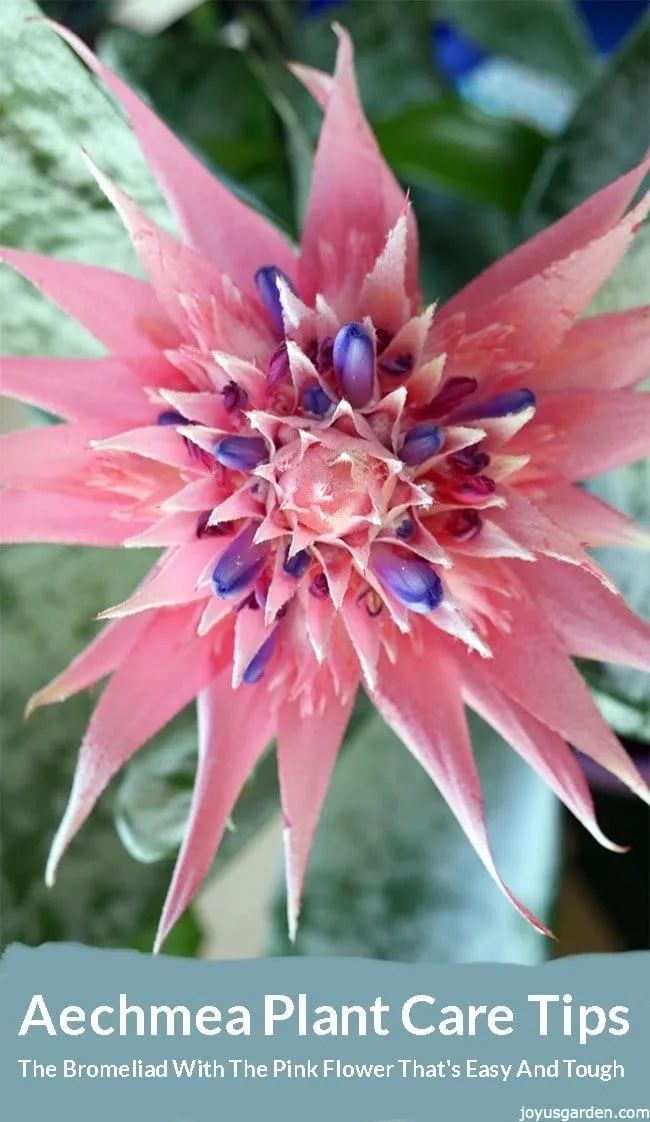Earth Star Plant Care: Growing A Cryptanthus Bivittatus
Are you looking for a sweet, colorful plant with beautiful foliage that stays small? You’ve found it. Cryptanthus bromeliads are easy-care as can be and petite enough to tuck in almost anywhere. Learn how to care for an Earth Star Plant, indoors and outdoors.
I love these plants and grew them in pots in my Santa Barbara garden year-round. I’ve since moved to Tucson and now grow them indoors. They’re in the Bromeliad family but differ from other bromeliads in one way. This is good to know in regard to their care.
What are bromeliads?

Most bromeliads, like Guzmanias, Neorgelias, and Aechmeas, are epiphytic. This means that they grow on plants and rocks in their native environments. Air Plants are very popular houseplants and are also bromeliads.
Cryptanthus grow in the ground which means have a more developed root system, prefer a different soil mix, and are watered differently.
There are many cultivars and species of Cryptanthus which have a variety of foliage patterns and colors, as well as sizes. The Pink and Red Earth Stars are the ones I’m most familiar with. They’re the ones most commonly sold in the houseplant trade and the ones I’m writing about here.
Their botanical name is Cryptanthus bivittatus. Names they commonly go by are Earth Star Plant, Earth Star, Earth Star Bromeliad, Pink Earth Stars, Red Earth Stars, Pink Star Plant, and Red Star Plant.
I’ve done many posts on Bromeliad care. Here’s a Bromeliads 101 Guide as well as Air Plant Care you’ll find helpful.
Earth Star Plants Traits
Uses
On tabletops, in dish gardens, terrariums, and on living walls.
Size
They’re small plants with a rosette shape. The plants reach 6″ high and can spread to 12″ depending on the number of pups (babies) in the pot. They’re sold in 2″, 4″ and 6′ pots. My 6″ plant is 12″ wide and my 4″ plant is 8″ wide.
Growth Rate
Slow.

Earth Star Plant Care
Cryptanthus Light Requirements
Cryptanthus Earth Stars like strong bright light but no direct, hot sun. Too much sun = bleaching out. Too low light levels = loss of color (red or pink) that leads to one turning light green.
I keep mine in medium light in my kitchen where it receives natural light all day long.
Cryptanthus Watering
This is where they differ from the epiphytic bromeliads. Because they’re terrestrial, they like the soil mix to be watered on a more regular basis.
I don’t let the mix dry out in late spring, summer, and early fall when the temps are warmer here. On the other hand, I don’t keep it bone dry either.
I water mine less often in the winter.
Here’s how often I water mine: In summer, it’s every 7-10 days and every 10 – 20 days in winter.
I use room temperature water as with all my indoor plants.
Humidity
An Earth Star is a tropical plant that is native to a humid environment. I live in an arid climate, but mine do well nonetheless.
I’ve found them to be adaptable as far as humidity levels go. We do have a summer monsoon season but for most of the year, we’re desert dry.
Here’s what I do to Increase The Humidity factor for my subtropical and tropical houseplants.
Temperature
If your home is comfortable for you, then your indoor plants will be comfortable also. Just be sure to keep yours away from any cold drafts and air conditioning or heating vents.
A Cryptanthus bivittatus is fairly tolerant of a wide range of temperatures but does prefer cooler temperatures at night. I grew them year-round outdoors in my Santa Barbara garden (USDA plant hardiness zone 10a) where the temperatures fluctuated but never extremely.
Feeding / Fertilizing
I never fertilized mine that grew outdoors. I did give them a light topdressing of worm compost and compost in the spring.
Now that I grow Earth Stars indoors, I give them a feeding 3 times during the growing season with Maxsea All-Purpose diluted to 1/2 strength.
If you think yours need fertilizing, feed it with a balanced formula houseplant food (like 10-10-10). Our growing season is long here so once or twice a year might be all your plant needs.
Soil
The root system of an epiphytic bromeliad serves the primary purpose of anchoring the plant to whatever it’s growing on. Cryptanthus bivtittatus grows in the ground on the rainforest floors and has a slightly more extensive root system. They like well-drained soil that is loose and well aerated to prevent root rot.
I use a mixture of even parts potting soil, pumice (or perlite), and coco coir (a more environmentally friendly sub for peat moss )when repotting these plants. I’ll toss a scant handful or 2 of compost to provide that richness that they like.
Regular potting soil is too heavy to use for planting but you can light it up by going 1:1 with orchid bark.

Repotting
They don’t need it often, if at all. I repotted my 4″ Pink Earth Star 2 years ago because 2 of the pups fell out of the pot when I brought it home from Green Things Nursery.
I repotted it (the mother plant and the pups together) using the soil mixture above. The pups have since rooted in and the plant (which you’ll see in the video) is doing great.
If you need to repot yours, spring and summer are the best times to do it.
In terms of pot size, go up 1 at the most. For instance, from a 4″ nursery pot to a 6″ nursery pot. When the time comes, yours may not need a bigger pot, but fresh potting mix after 4 years or so is always a good idea.
Pruning
This is another thing your Cryptanthus may not need because they grow slowly and stay compact. If one of the lower leaves is dead, then you’ll need to cut it off.

Propagation
You propagate an Earth Star by its pups (or babies) that are produced at the base of the plant. You’ll see those pups start to form off the base of a healthy plant. That mother plant will slowly start to die (after that sad but true – it’s just part of the life cycle!) but the babies live on.
You can just cut away the mother plant’s foliage after it’s completely dried and dead leaving the pups to form and grow in that same pot. Or, you can remove the pups after they’ve gotten big enough and put them in their own pot.
Pests
This is another area where I’ve found a Cryptanthus to be a hassle-free plant. Mine has never gotten any pest infestations.
I’ve heard they can be susceptible to scale insects, both soft and hard shells. So, keep your eye out for Mealybugs and Scale.
These critters tend to live inside where the leaf hits the stem and also underneath the leaves so check these areas from time to time.
It’s best to take action as soon as you see any pests because they multiply like crazy. They can travel from plant to plant fast, so get them under control asap.
Flowers
They appear in the center of the plant. The small white flowers are nowhere as showy as a Guzmania, Aechmea, or Pink Quill Plant but they are sweet.
Like other Bromeliads, the mother plant will eventually brown and die after flowering. The pups are produced just before or just after flowering.
Pet Safety
Ring the bells! Earth Star plants are non-toxic. I consult the ASPCA website for this information.
Just know that if your pet chews on an Earth Star’s crunchy leaves (so appealing!), it could make them sick.
Earth Star Care Video Guide
Cryptanthus Bromeliad FAQs
How often do you water a Cryptanthus?
It depends on the pot size, the type of soil it’s planted in (good drainage is important), its growing location, and your home’s environment.
I’ll share with you how I water mine. In summer, it’s every 7-10 days and every 10-20 days in winter.
How do Earth Stars propagate?
The easiest way is from the small pups or babies that grow off the original plant. You can separate them from the mother when they’re large enough.
Why is my Earth Star plant losing color?
It’s usually caused by light intensity; either too much sun or not enough light.
Why is my Earth Star plant turning green?
Again, this is due to the light conditions over time. It doesn’t happen right away and can occur in the wintertime when light levels are lower. Locating it to brighter light (not direct sun) should bring the color back.
Are Cryptanthus bivittatus poisonous to cats?
No, the Earth Stars are not. Just be aware that some kitties like to chew on those crunchy leaves.
Is Earth Star Plant a succulent?
No, they are classified as bromeliads and not succulents.
Where can I buy a pink or red Earth Star bromeliad?
I’ve always bought mine from local nurseries and growers in CA and AZ. I’ve seen them for sale online on Etsy, Amazon, Pistil Nursery, and Jordan’s Jungle.
Some Of Our General Houseplant Guides For Your Reference:
- Guide To Watering Indoor Plants
- Beginner’s Guide To Repotting Plants
- 3 Ways To Successfully Fertilize Indoor Plants
- How to Clean Houseplants
- Winter Houseplant Care Guide
- Plant Humidity: How I Increase Humidity For Houseplants
- Buying Houseplants: 14 Tips For Indoor Gardening Newbies
- 11 Pet-Friendly Houseplants

1. Earth Star (3 Pack) // 2. Cryptanthus Bivittatus Red Star Bromeliad // 3. Pink Earth Star Plant
Conclusion
There are 2 things to keep in mind when growing a Cryptanthus. They like bright, natural indirect light and to be kept not too wet or not too dry.
Earth Star Plants are another easy-care option to add to your home’s living decor!
Happy gardening,

Looking for more gardening tips? Check these out!






